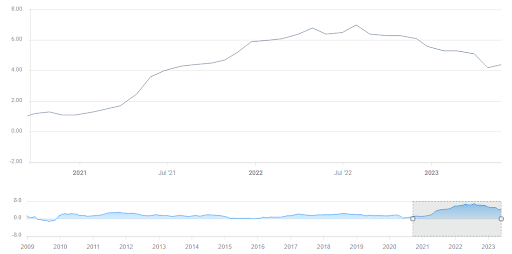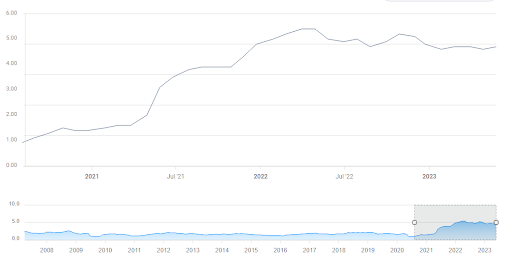- The US Personal Consumption Expenditure figure is a better measure of real-time inflation.
- Federal Reserve officials examine this report to make mortgage-impacting interest rate decisions.
- The US Dollar responds to this publication, influencing prices of imported goods and vacations.
- PCE data for May is set to show inflation remains stubbornly high.
Isn't inflation data already out? Think again – the Consumer Price Index (CPI) is the report getting all the attention, but the less-known Personal Consumption Expenditure (PCE) Price Index is no less important and for three reasons.
Here is why you should watch the PCE release and what to expect from the upcoming publication on Friday at 12:30 GMT.
1) Why PCE inflation is more meaningful for your pocket
Inflation is the change in prices of products and services people consume, where every item has a different weight according to the amount bought by Americans. Rent has a greater weight than a hotel stay, and a car has larger weight than furniture.
Both the CPI and the PCE inflation indexes are based on such calculations. Still, the difference is in the frequency they are updated – economists responsible for the PCE update it more frequently, according to how people change their consumption patterns.
For example, if the price of tomatoes leaps and people buy more cucumbers, the CPI will increase vegetable prices as driven by soaring tomato prices without considering that less tomatoes are being bought. However, the PCE will adapt to modified consumption patterns, giving cucumbers more weight and tomatoes a minor impact on vegetable prices.
In the example above, PCE inflation would be lower than the CPI one, but this is not always true. Beyoncé is on tour, and fans cannot get enough of her shows – prices are rising and the PCE has adjusted in real-time to reflect higher ticket prices. In Sweden, her shows triggered a leap in hotel and restaurant prices, and some analysts say that this contributed to raising national inflation.
The PCE is off the peak, but it advanced from 4.2% to 4.4% in April, contrary to CPI, which fell that month:

Source: FXStreet
PCE is expected at 4.6% in May, still too high, but more up-to-date than CPI. All in all, the former better reflects prices in real-time, so it is worth watching it more closely.
2) Federal Reserve officials watch Core PCE and that impacts mortgage and other lending rates
You borrow money from your bank, and your bank's interest rates depend on the central bank, the Federal Reserve. If you want to buy a house or take out a loan to buy a new car, the Fed is worth watching – and it watches PCE inflation.
More importantly, officials in Washington eye Core PCE. What is the difference? Economists separate between overall price changes, and those that are less volatile – excluding energy and food prices. While you need food to move on and your car needs gas to do the same, these are prices the Fed tends to look through when deciding on interest rates.
Oil prices are set in international markets – impacted by output cuts in Saudi Arabia, Chinese consumption and not only US production and consumption. Food prices are also set globally, influenced by falling Ukrainian supply, droughts in faraway countries and how people consume it all over.
Through interest rates, the Fed impacts the prices of everything else. If borrowing costs are high, people tend to save more and take out fewer loans, pushing demand and prices down. If rates fall, there is more money running around, boosting inflation.
So, this chart of Core PCE matters to the Fed:

Source: FXStreet
Core PCE stood at 4.7% in April, and a repeat of this level is expected in the upcoming release for May. If it beats expectations, mortgage rates may rise. Likewise, lending costs could drop if it falls short of projections.
3) PCE inflation impacts the US Dollar via Fed decisions
The Federal Reserve watches PCE – so financial markets also examine it closely. The higher it goes, the greater the chance for further rate hikes and thus a stronger US Dollar. The Greenback would lose value against its peers on a lower read.
Why does the value of the currency matter? If you buy goods made abroad, a stronger US Dollar makes them cheaper. It also makes your potential trip to Europe or other places a better bargain. If inflation falls, it may be good for day-to-day costs, but any such vacation or purchase of foreign-made products becomes more expensive.
That is another reason to follow this publication, especially if you are on the verge of using your dollars outside the US.
May's report is set to show inflation is stubbornly high
Looking at the economic calendar, inflation as measured by the Core PCE is expected to remain at 4.7% YoY, or rise by 0.4% – too fast – monthly. That means your dollars are still losing value at a frustrating pace, but if you go for a summer vacation abroad, you're in for a better bargain.
If the outcome is weaker, it would show that price rises are slowing, and your money goes further. A leap in PCE inflation would show the opposite – that real costs are re-accelerating.
Conclusion
Consumers tend to overlook PCE inflation – but there are good reasons that justify examining it closely. It is a better measure of price rises and has a stronger impact on the Fed, which influences interest rates and the US Dollar’s exchange rate.
The upcoming release is set to show inflation is still sticky – not going down fast enough.
United States Personal Consumption Expenditures - Price Index (MoM)
The Personal Spending released by the Bureau of Economic Analysis, Department of Commerce is an indicator that measures the total expenditure by individuals. The level of spending can be used as an indicator of consumer optimism. It is also considered as a measure of economic growth: While the Personal spending stimulates inflationary pressures, it could lead to rise interest rates. A high reading is positive (or Bullish) for the USD. Read more.
Next release: Friday June 30, 2023 12:30:00 GMT
Frequency: Monthly
Source: US Bureau of Economic Analysis
Information on these pages contains forward-looking statements that involve risks and uncertainties. Markets and instruments profiled on this page are for informational purposes only and should not in any way come across as a recommendation to buy or sell in these assets. You should do your own thorough research before making any investment decisions. FXStreet does not in any way guarantee that this information is free from mistakes, errors, or material misstatements. It also does not guarantee that this information is of a timely nature. Investing in Open Markets involves a great deal of risk, including the loss of all or a portion of your investment, as well as emotional distress. All risks, losses and costs associated with investing, including total loss of principal, are your responsibility. The views and opinions expressed in this article are those of the authors and do not necessarily reflect the official policy or position of FXStreet nor its advertisers. The author will not be held responsible for information that is found at the end of links posted on this page.
If not otherwise explicitly mentioned in the body of the article, at the time of writing, the author has no position in any stock mentioned in this article and no business relationship with any company mentioned. The author has not received compensation for writing this article, other than from FXStreet.
FXStreet and the author do not provide personalized recommendations. The author makes no representations as to the accuracy, completeness, or suitability of this information. FXStreet and the author will not be liable for any errors, omissions or any losses, injuries or damages arising from this information and its display or use. Errors and omissions excepted.
The author and FXStreet are not registered investment advisors and nothing in this article is intended to be investment advice.
Recommended Content
Editors’ Picks

EUR/USD extends recovery beyond 1.0400 amid Wall Street's turnaround
EUR/USD extends its recovery beyond 1.0400, helped by the better performance of Wall Street and softer-than-anticipated United States PCE inflation. Profit-taking ahead of the winter holidays also takes its toll.

GBP/USD nears 1.2600 on renewed USD weakness
GBP/USD extends its rebound from multi-month lows and approaches 1.2600. The US Dollar stays on the back foot after softer-than-expected PCE inflation data, helping the pair edge higher. Nevertheless, GBP/USD remains on track to end the week in negative territory.

Gold rises above $2,620 as US yields edge lower
Gold extends its daily rebound and trades above $2,620 on Friday. The benchmark 10-year US Treasury bond yield declines toward 4.5% following the PCE inflation data for November, helping XAU/USD stretch higher in the American session.

Bitcoin crashes to $96,000, altcoins bleed: Top trades for sidelined buyers
Bitcoin (BTC) slipped under the $100,000 milestone and touched the $96,000 level briefly on Friday, a sharp decline that has also hit hard prices of other altcoins and particularly meme coins.

Bank of England stays on hold, but a dovish front is building
Bank of England rates were maintained at 4.75% today, in line with expectations. However, the 6-3 vote split sent a moderately dovish signal to markets, prompting some dovish repricing and a weaker pound. We remain more dovish than market pricing for 2025.

Best Forex Brokers with Low Spreads
VERIFIED Low spreads are crucial for reducing trading costs. Explore top Forex brokers offering competitive spreads and high leverage. Compare options for EUR/USD, GBP/USD, USD/JPY, and Gold.